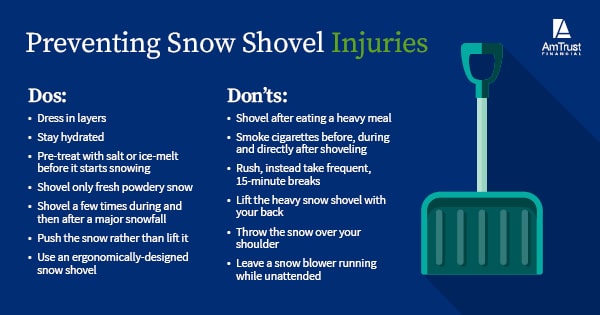Summary: With winter storms on their way, now is the time for employers to prepare their staff for the risks that can come with snow removal. Learn the health risks and how to prevent them to keep your employees safe this winter. Winter weather hits hard in some parts of the country. Knowing about some of the common
winter weather hazards facing your employees and the health risks involved in the snow removal process is vital to the safety of a small business’s staff. Sidewalks and
parking lots need to be properly maintained to keep the
property safe for workers and customers.
Shoveling snow can be very taxing on the body and could lead to a variety of injuries. A shovel full of dry, fluffy snow weighs up to seven pounds per cubic foot. In contrast, a shovel full of wet snow can weigh up to 20 pounds per cubic foot and greatly increase the chance of an injury.

Common Snow Shoveling Injury Risks
An
American Journal of Emergency Medicine study looked at medical emergency data from 1990 to 2006. During that time, 195,000 people in the U.S. were treated in a hospital for a snow shoveling injury with 1,647 resulting in a fatality. The majority of injuries occurred in adult men. The leading cause of death from snow shoveling was due to heart problems in the victims.
Injuries from snow shoveling include:
- Lower back injuries
- Muscle, ligament, tendon and other soft tissue injuries
- Cuts and broken bones
- Head injuries
- Heart-related issues
The
American Heart Association warns that the risk of a heart attack while shoveling snow may increase for some, as the combination of colder temperatures and physical exertion can be very dangerous. Exposure to cold weather can increase heart rate and blood pressure while also constricting the arteries and reducing oxygen to the heart. In fact, adults over age 55 are 4.25 times more likely than younger people to have heart-related symptoms when shoveling.
Certain individuals have a higher risk of a heart attack during cold outdoor activity and they caution that anyone over 40 years old should take extra caution when shoveling, including:
- People with a prior heart attack
- People with known heart disease
- People with high blood pressure or high cholesterol
- Smokers
- People who lead a more sedentary lifestyle
Snowblower Injury Risk
Snowblower usage causes more than
5,000 severe injuries per year . Most snow blower injuries occur to the hand and can range from cuts and lacerations to amputations. As with shoveling, heavy snow is the culprit, but in the case of the snow blower, it is the heavy snow blocking the inner parts of the machine causing investigation and possible injury. For instance, an individual may reach in to clear snow from the inside before the blades have completely stopped moving, resulting in an injury.
Winter Safety Tips for Snow Shoveling

Having a clear
walkway or driveway free of snow and ice is vital to productivity for small businesses throughout the winter. From the American Heart Association to your own doctor’s advice to the
National Safety Council, there are many dos and don’ts for snow removal safety:
Dos: - Stretch and do at least a 10-minute warm-up before heading outside to shovel
- Dress in layers to prevent hypothermia and cover your mouth, head and neck
- Stay hydrated by drinking plenty of water when shoveling
- Pre-treat the parking lot and sidewalk with salt or ice-melt before it starts snowing
- Shovel only fresh powdery snow
- Shovel a few times during and then after a major snowfall
- Push the snow rather than lift it - if you have to lift, use a smaller shovel or only partially fill the shovel
- Use an ergonomically-designed snow shovel
- Keep your hands away from the moving parts on a snowblower
- If the snowblower jams, turn it fully off before investigating the problem
- Know the signs of a heart attack, stop shoveling immediately and call 911 if you are experiencing any symptoms
Don’ts: - Shovel after eating a heavy meal
- Smoke cigarettes before, during and directly after shoveling
- Rush, instead take frequent, 15-minute breaks
- Lift the heavy snow shovel with your back, always lift the shovel with your legs
- Throw the snow over your shoulder as this adds more stress to your back
- Leave a snow blower running while unattended
Following these tips will help keep your
workplace and workers safe during the winter months, plus help prevent injuries for those workers who take care of snow removal during the winter months.
Workplace Safety Tips from AmTrust Financial
AmTrust’s
Loss Control Department knows that access to the correct
workplace safety resources is vital for a successful business. We can give you the individual attention you deserve, identifying specific hazards and offering recommendations that fit your operation. For more information, please
contact us today.
 This material is for informational purposes only and is not legal or business advice. Neither AmTrust Financial Services, Inc. nor any of its subsidiaries or affiliates represents or warrants that the information contained herein is appropriate or suitable for any specific business or legal purpose. Readers seeking resolution of specific questions should consult their business and/or legal advisors. Coverages may vary by location. Contact your local RSM for more information.
This material is for informational purposes only and is not legal or business advice. Neither AmTrust Financial Services, Inc. nor any of its subsidiaries or affiliates represents or warrants that the information contained herein is appropriate or suitable for any specific business or legal purpose. Readers seeking resolution of specific questions should consult their business and/or legal advisors. Coverages may vary by location. Contact your local RSM for more information.